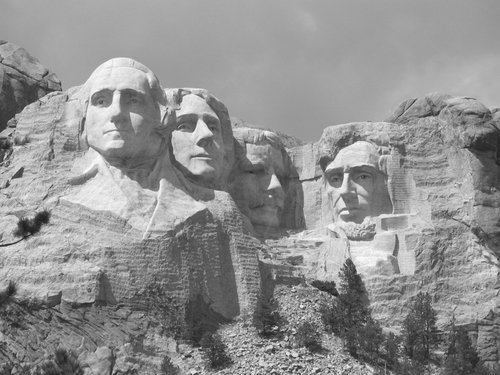
To spawn off of the classes discussion last week about Native American’s and preservation, one iconic topic that has since started to fade is the creation of Mount Rushmore. To many it is a historical landmark that celebrates the nation’s fathers: Washington, Lincoln, Jefferson, and Theodore Roosevelt. What has been lost in translation is the history of how this landmark came to be.
The Lakota tribe suffered defeat in the Great Sioux War in 1876 against the Americans. What this meant was that their land, the land that was fought on, was stripped from them. The mountain range on the land was called Six Grandfathers. It is interesting to note that though Americans stole the mountain, an interesting parallel of preservation happened in a unique way. While though we look at the definition to preservation as more of a physical, traditionally made, sort of way, the concept of intention has brought a new level to the table. With the fathers of our country now displayed at gigantic proportions, to the Native American’s the mountain was an ode to their own ancestors. I feel there might have been some sort of subconscious decision that went into creating the monument.
In the 1920’s, the process of Mount Rushmore began. Its original intent, that holds strong even to today, was to bring tourism up to the area where the monument was, South Dakota. Eventually the National Park Service began to work with making the monument to make it successful and complete project. From the beginning of its conception, Mount Rushmore was perceived as historically significant, and after the involvement of the NPS, the concept of preservation started to change to conservation.
We would only be fooling ourselves if we say that Mount Rushmore is being preserved when in actuality it is merely maintained. It was once a cherished mountain to the Native Americans; to say that we continued to preserve it after we sculpted the face of the mountain into a work of art is preposterous. We did indeed conserve the land in order to bring forth more visitors. The ironic thing is that after the defacing of the environment the NPS then declared it a place of conservation, and preceded with rules to further prevent destruction to the environment. Destruction not unlike what created Mount Rushmore in the first place.
My own opinion on Native American land preservation is from a very American stance. In a way Native American history is not part of American history, because it was pre-American. In the case of Mount Rushmore, I see it as land that was stolen but used in a similar manner. Mount Rushmore is dedicated to some of the greatest presidents that the country has had. We as people visit this spot as a remembrance of what this country is made up of. Similar to Native American culture, where the land was their religion, and they worshiped it in such a way that was respectful. Even though this spot was taken from blood, today we maintain at least the level of respect that the Native Americans once had for the area.
I really liked your topic. That is one of the most iconic images in North America. I think of it so differently now having been reminded of its past. What an insult that seems - to take away one of the biggest and best views/mountains of a places indigenous people, and pasting your leader's faces on it. Different perspective on an American icon, for sure. And pointing out the preservation issues coming in t play on something that wasn't ours to begin with, good point, touché. Though I do tend to agree with you on the fact that this sort of thing has been going since the beginning of time. The first thing that popped in to my head was someone "pissing on a tree," by the way. Hope that is relevant, that was what I got from your introductory explanation. Nice post, as usual.
ReplyDeleteVery interesting blog, not many people think of how we got the land we now try and preserve today. Although I have respect and agreement that most of the land we call today was unfairly stolen from Native American tribes, the fact that we won the land that Mt Rushmore now sits on is far from what I would call stolen, maybe the spoils of war. That's usually what wars generate, more land for the victor. so to say it was stolen is a little hard pressed. Besides that I agree greatly with what you blog has to say, we did a far cry from truly preserving Mt Rushmore after we turned an entire rock face into the faces of our nation's fathers. Your statement about the Native American's using the land as an ode to their forefathers is an interesting fact and I too wonder if there is some subconscious decision to that land now honoring our forefathers, or if it is a sort of punch in the face towards the Native Americans to deface the land they used to honor their fathers and stamp it with the faces of ours.
ReplyDeleteI never thought about Mount Rushmore as a project that was a defaced mountain. When I think about Mount Rushmore and preservation, I think about the memorial itself being preserved, but we're merely preserving an unpreserved mountain face. Very interesting to think in terms of that.
ReplyDeleteBuilding off of Ryan's comment, looking through the eyes of Native Americans, I can also see how Mount Rushmore mint pose as an insult. Though brought up in class last week, civilization progresses by defeats of one population on another, I don't think it's something worth feeling bad about, but definitely food for thought.